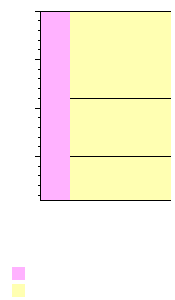Proterozoic
| Proterozoic eon |
|---|
| The Proterozoic eon comprises the Paleo-, Meso-, and Neo- proterozoic eras, and is preceded by the Archaean eon. |
| 2500 - 542 millions of years ago |
 (expand) |
The Proterozoic (IPA: /ˌprəʊt(ə)rəˈzəʊɪk/) is a geological eon representing a period before the first abundant complex life on Earth. The Proterozoic Eon extended from 2500 Ma to 542.0 ± 1.0 Ma (million years ago). The Proterozoic is the most recent part of the old informal Precambrian time.
The Proterozoic consists of 3 geologic eras, from oldest to youngest:
- Paleoproterozoic
- Mesoproterozoic
- Neoproterozoic
The well-identified events were:-
- The transition to an oxygenated atmosphere during the Mesoproterozoic.
- Several glaciations, including the hypothesized Snowball Earth during the Cryogenian period in the late Neoproterozoic.
- The Ediacaran Period (635 to 542 Ma) which is characterized by the evolution of abundant soft-bodied multicellular organisms.
The Proterozoic Record
The geologic record of the Proterozoic is much better than that for the preceding Archean. In contrast to the deep-water deposits of the Archean, the Proterozoic features many strata that were laid down in extensive shallow epicontinental seas; furthermore, many of these rocks are less metamorphosed than Archean-age ones, and plenty are unaltered.[1] Study of these rocks show that the eon featured massive, rapid continental accretion (unique to the Proterozoic), supercontinent cycles, and wholly-modern orogenic activity.[2]
The first known glaciations occurred during the Proterozoic; one began shortly after the beginning of the eon, while there were at least four during the Neoproterozoic, climaxing with the "Snowball Earth" of the Varangian glaciation.[3]
The Build-up of Oxygen
One of the most important events of the Proterozoic was the gathering up of oxygen in the Earth's atmosphere. Though oxygen was undoubtedly released by photosynthesis well back in Archean times, it could not build up to any significant degree until chemical sinks—unoxidized sulfur and iron—had been filled; until roughly 2.3 billion years ago, oxygen was probably only 1% to 2% of its current level.[4] Banded iron formations, which provide most of the world's iron ore, were also a prominent chemical sink; most accumulation ceased after 1.9 billion years ago, either due to an increase in oxygen or a more thorough mixing of the oceanic water column.[5]
Red beds, which are colored by hematite, indicate an increase in atmospheric oxygen after 2 billion years ago; they are not found in older rocks.[5] The oxygen build-up was probably due to two factors: a filling of the chemical sinks, and an increase in carbon burial, which sequestered organic compounds that would have otherwise been oxidized by the atmosphere.[6]
Proterozoic Life
The first advanced single-celled and multi-cellular life roughly coincides with the oxygen accumulation; this may have been due to an increase in the oxidised nitrates that eukaryotes use, as opposed to cyanobacteria.[6] It was also during the Proterozoic that the first symbiotic relationship between mitochondria (for animals and protists) and chloroplasts (for plants) and their hosts evolved.[7]
The blossoming of eukaryotes such as acritarchs did not preclude the expansion of cyanobacteria; in fact, stromatolites reached their greatest abundance and diversity during the Proterozoic, peaking roughly 1.2 billion years ago.[8]
Classically, the boundary between the Proterozoic and the Paleozoic was set at the base of the Cambrian period when the first fossils of animals known as trilobites and archeocyathids appeared. In the second half of the 20th century, a number of fossil forms have been found in Proterozoic rocks, but the upper boundary of the Proterozoic has remained fixed at the base of the Cambrian, which is currently placed at 542 Ma.
See also
- Timetable of the Precambrian
ReferencesISBN links support NWE through referral fees
| Geologic Time (ca. 4500 million years ago - present) | |||
|---|---|---|---|
| Hadean | Archean | Proterozoic | Phanerozoic |
| Precambrian (ca. 4500 - 542 million years ago) | |||
| Proterozoic eon (2500 - 542 million years ago) | |||||||||
|---|---|---|---|---|---|---|---|---|---|
| Paleoproterozoic era | Mesoproterozoic era | Neoproterozoic era | |||||||
| Siderian | Rhyacian | Orosirian | Statherian | Calymmian | Ectasian | Stenian | Tonian | Cryogenian | Ediacaran |
| ----------X--------------------------Three probable snowball earth episodes.------------------------------------X—X---- | |||||||||
Credits
New World Encyclopedia writers and editors rewrote and completed the Wikipedia article in accordance with New World Encyclopedia standards. This article abides by terms of the Creative Commons CC-by-sa 3.0 License (CC-by-sa), which may be used and disseminated with proper attribution. Credit is due under the terms of this license that can reference both the New World Encyclopedia contributors and the selfless volunteer contributors of the Wikimedia Foundation. To cite this article click here for a list of acceptable citing formats.The history of earlier contributions by wikipedians is accessible to researchers here:
The history of this article since it was imported to New World Encyclopedia:
Note: Some restrictions may apply to use of individual images which are separately licensed.